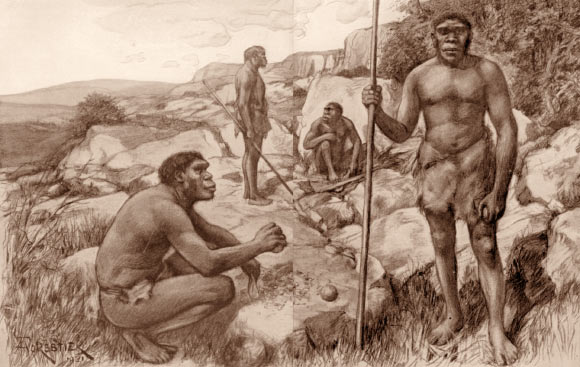An international team of archaeologists and paleoanthropologists has found fossil faunal remains and associated stone tools at the middle Pleistocene (300,000-500,000 years ago) locality of Ti’s al Ghadah in the Nefud Desert of Saudi Arabia. The discovery, reported in the journal Nature Ecology & Evolution, shows that hominins were present in the Arabian Peninsula at least 100,000 years earlier than previously known.
Ti’s al Ghadah is one of the most important paleontological sites in the Arabian Peninsula, representing the only dated collection of middle Pleistocene fossil animals (elephants, jaguars and water birds) in this part of the world.
Until now, however, the absence of stone tools has made linking these animals with early hominin presence uncertain.
“Our discoveries make Ti’s al Ghadah the first, early hominin-associated fossil assemblage from the Arabian Peninsula, demonstrating that our ancestors were exploiting a variety of animals as they wandered into the green interior,” said co-lead author Dr. Michael Petraglia, a researcher at the Max Planck Institute for the Science of Human History.
“In spite of its crucial geographic position at the crossroads between Africa and Eurasia, the Arabian Peninsula has been astoundingly absent from discussions about early human expansions until recently,” added co-lead author Mathew Stewart, PhD candidate at the University of New South Wales.
“However, recent analysis of climate models, cave records, lake records, and animal fossils has shown that at certain points in the past, the harsh, hyper-arid deserts that cover much of Arabia today were replaced by ‘greener’ conditions that would have represented an attractive setting for various hominin populations.”
Stable isotope analysis of fossil animal remains reveals that the Arabian Peninsula was dominated by grassland vegetation at certain points in the past, with aridity levels similar to those found in open savanna settings in eastern Africa today.
This indicates that early dispersals of our archaic ancestors were part of a range expansion rather than a result of novel adaptations to new environmental contexts outside Africa.
“While these early hominin populations may have possessed significant cultural capacities, their movement into this part of the world would not have required adaptations to harsh and arid deserts,” said co-lead author Dr. Patrick Roberts, a scientist at the Max Planck Institute for the Science of Human History.
“Indeed, the isotope evidence suggests that this expansion is more characteristic of a range expansion similar to that seen among other mammals moving between Africa, the Levant, and Eurasia at this time.”
“More detailed study of past environments, closely associated with different forms of hominin species in the Arabian Peninsula and elsewhere, should enable more refined testing as to whether our species is uniquely flexible in terms of its adaptations to varying environments.”
_____
Patrick Roberts et al. Fossil herbivore stable isotopes reveal middle Pleistocene hominin palaeoenvironment in ‘Green Arabia.’ Nature Ecology & Evolution, published online October 29, 2018; doi: 10.1038/s41559-018-0698-9








